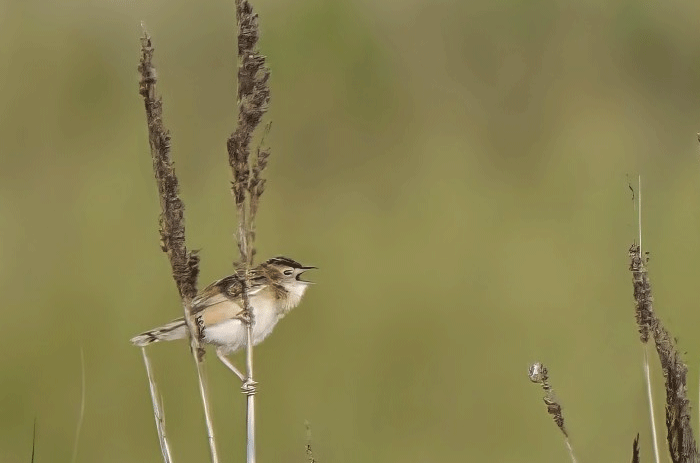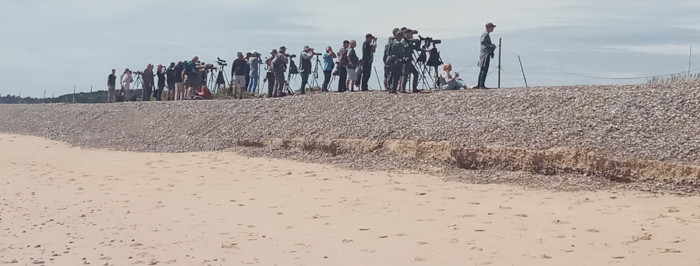Finders-in-the-Field: Zitting Cisticola Walberswick, Suffolk

Every August my family and I stay in Walberswick on the Suffolk coast. The rest of the year we live near Montpellier, France, where zitting cisticolas are common.
On Thursday 31 July, we took our first walk across the marshes of Walberswick National Nature Reserve. Approximately 500m south of the caravan site, I heard an unexpected bird song from the direction of the beach. It sounded like a zitting cisticola with the tone and quality of a repetitive, short and insistent yellow wagtail call. Against the sound of wind in the reeds and the distant waves, it was difficult to distinguish clearly. After five minutes of listening, we dismissed it, assuming it to indeed be an unusually calling wagtail or similar. But I made a mental note to check the area behind the beach on my next walk.
I had a bird survey planned on Sunday 3rd August for the area of marshland to the south of the Walberswick beach huts, as part of a local campaign against an electricity cabling route, which, astonishingly, is planned to make landfall and impact this European protected site (see https://www.wall-update.org for further information). We had a busy family day planned, so I made the survey short, and then proceeded to walk our dog south along the beach.
It was a cloudless, relatively calm day, and only 200m into the walk, I caught the distant strains of the same bird. Again, it sounded like a zitting cisticola, emanating from an area of shingle, marram grass and reed, with a large patch of sea buckthorn, immediately behind the beach. It appeared to be moving as the song moved, yet I couldn’t see it – typical of a song-flighting cisticola. In a state of disbelief and equipped only with binoculars, I busied myself with recording a spoonbill landing on the lagoon to the north, when an inner voice cried ‘look at the cisticola, please, we’re in Suffolk, not Montpellier!’.
I crept closer to the bird and managed to lock on to it song-flighting. A small bird, with rounded body and distinctive tail twitching downwards with each ‘zit’, resulting in a shallow undulating flight through a high arcing flightpath. There was no doubt this was a zitting cisticola. I followed it several times in flight, ranging between the floodbank to the north and buckthorn scrub to the south. It alighted on the top of the scrub, and I was able to view it from 20m. I noted the bold dark streaking on the upperparts, pale throat and breast, and warm buffy orange flanks and rump set against a slate grey tail. After a vain attempt to photograph it, I managed to make a recording of the song, complete with my barking dog!
In shock and with a busy day ahead, I had to make decisions. The bird had clearly been holding a territory for several days in suitable breeding habitat, so before putting the news out I needed to check this wasn’t a known breeding attempt being suppressed for conservation reasons. The bird was holding territory over an area within electric fencing and would be habituated to the frequent walkers on the adjacent beach crest; I considered there should be no risk of disturbance from a twitch. I messaged my local birding friend, Pat Lancaster, who in turn alerted Brian Small who is well-connected to the local birding community and sent him the song recording. Within minutes they were on their way! Obviously, it was not already known about and supressed. I had to leave but was satisfied to see the news broadcast within the hour.
That evening, I returned to the site. There was a small group of observers, including two old birding mates, and we watched the bird together until dusk.

Almost three weeks on, and the story has come full circle. After numerous rumours of a second bird and possible breeding behaviour, I had my own confirmatory moment. Early morning on Friday, whilst alone and watching the male repeatedly song-flighting, I glimpsed a second bird flying up from the reeds and interact with the male - there were two! Several birders arrived about an hour after. By 9am the wind had increased, and I walked home for breakfast, mulling over what I had seen and wondering when any young would fledge, if they were breeding. I didn’t have long to wait. At 1pm news was released of a fledgling being seen, and by the end of the day, three had reportedly been recorded . No wonder it has been holding territory with such tenacity.
Will the cable developers dare damage the first Zitting Cisticola breeding site in the UK?
August 2025
Share this story







